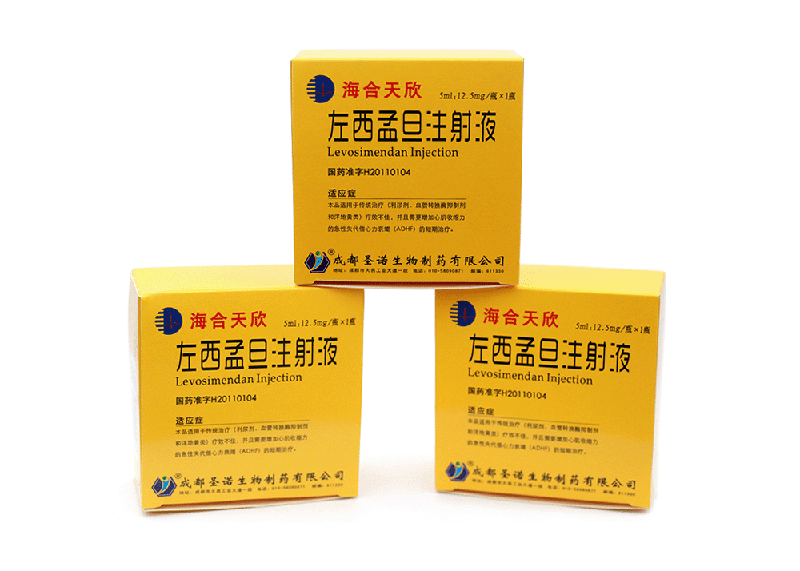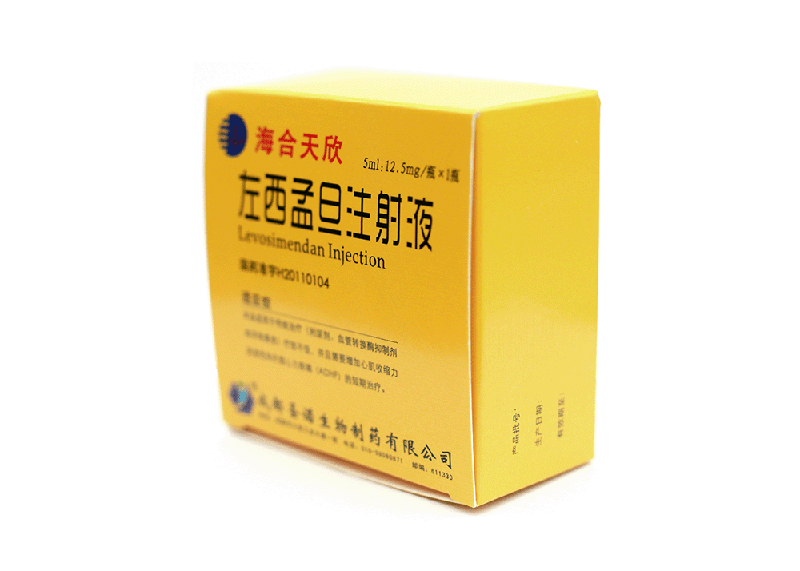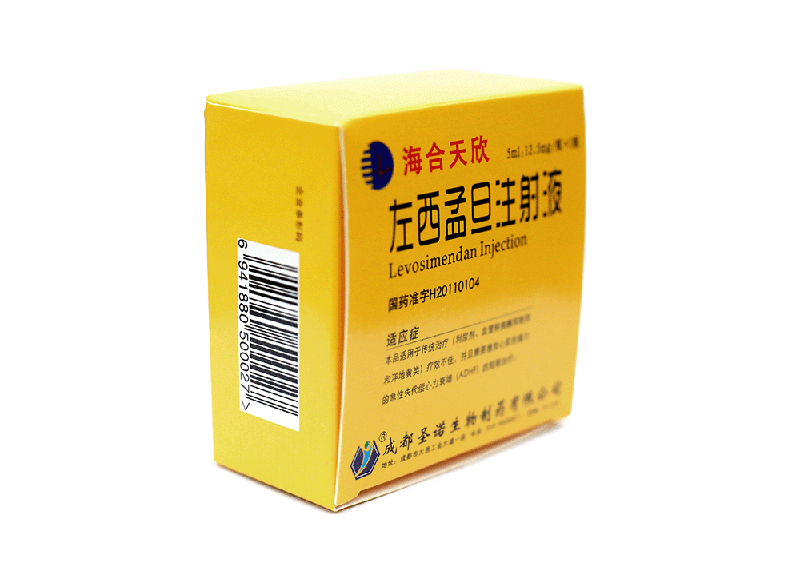Generic name: Levosimendan Injection
English name: Levosimendan Injection
Pinyin:zuoximengdan zhusheye
【Ingredients】Main ingredients:
Chemical name:
Molecular formula:
molecular weight:
Accessories:
【Character】This product is a clear liquid from yellow-green to orange-yellow.
【Indication】 This product is suitable for short-term treatment of acute decompensated heart failure (ADHF) that requires increased myocardial contractility due to poor efficacy of traditional therapies (diuretics, vascular conversion enzyme inhibitors, and digitalis).[usage and dosage]
This product is only used for inpatients, and should be used with appropriate medical monitoring equipment and experience in the use of positive inotropic drugs.
This product should be diluted before administration. This product is only used for intravenous infusion and can be administered by peripheral or central intravenous infusion. The dosage and duration of treatment should be adjusted according to the general situation and clinical manifestations of patients.
The initial load dose to be 6 to 12 microns /kg should be greater than 10 minutes, followed by continuous infusion 0.1 microns /kg/min(see table 1, 2). The recommended load dose at the beginning of treatment is 6 microns /kg for patients taking both vasodilators or/and inotropic drugs. Higher doses of stress have stronger hemodynamic effects and may lead to a brief increase in the incidence of adverse reactions. At load doses and during the first 30-60min of continuous administration, carefully monitor patient reactions such as hyperresponsiveness (hypotension, tachycardia) to 0.05g /kg/min or to discontinue administration. If the initial dose tolerance is good and hemodynamic effects need to be enhanced, the infusion rate can increase to 0.2g /kg/min.
For patients with acute decompensated severe chronic heart failure, the duration of continuous administration is usually 24 hours. No drug resistance or rebound was found after leosimendan was discontinued. Hemodynamic effects can last for at least 24 hours and may last for up to 9 days after withdrawal.
Limited experience in reusing leosimendan. Experience with other vasodilators such as myocardial systolic agents (other than digoxin) is limited and low load doses (6 microns /kg) are required to combine with vasoactive agents.
Before use, observe whether the diluent contains particulate impurities and discoloration. The diluted leosimendan infusion was injected separately. Use within 24 hours after infusion preparation.
Preparation method of 0.025mg/ml infusion: 5ml levosimendan injection was mixed with 500ml5% glucose injection;
Preparation of 0.05mg/ml infusion: 10ml lsimondan injection was mixed with 500ml5% glucose injection.
Monitoring of treatment:
Electrocardiogram (ecg), blood pressure and heart rate must be monitored and urine volume measured during treatment. Monitoring of these parameters should continue at least 3 days after the end of infusion or until the patient's clinical symptoms are relatively stable. For patients with mild or moderate kidney injury or mild or moderate liver injury, monitoring is recommended for at least 5 days.
Less than 30ml/min except for severe renal impairment, less than 30ml/min creatinine clearance is prohibited.
Patients with liver function impairment: patients with mild or moderate liver function impairment should be careful to use this product, but there is no need to adjust the dose, and it should be prohibited to use for patients with severe liver function impairment.
The following drugs can be used in conjunction with leosimendan:
Furosemide (diuretic) 10mg/ml
Digoxin (cardiac tonic) 0.25mg/ml
Nitroglycerin (for the prevention and treatment of angina pectoris) 0.1mg/ml
[adverse reactions]
The most common adverse reactions in clinical practice are headache, hypotension and ventricular tachycardia. The common adverse reactions are hypokalemia, insomnia, dizziness, tachycardia, ventricular premature beat, heart failure, myocardial ischemia, premature beat, nausea, constipation, diarrhea, vomiting, decreased hemoglobin, as shown in the table below. (form not typed)
【 taboo 】
1. Patients allergic to levosimendan or any other adjuvant;
2. Mechanical obstructive diseases that significantly affect ventricular filling or/or ejection function;
Less than 30ml/min for less functional impairment of liver and kidney; 3. Less than 30ml/min for less functional impairment of liver and kidney.
4. Patients with severe hypotension and tachycardia;
5. Patients with a history of tip torsion ventricular TdP.
[matters needing attention]
1, the hemodynamic effects of levosimendan early may cause cardiac systolic and diastolic blood pressure is reduced, therefore, basis for patients with lower systolic or diastolic blood pressure, or there is the risk of low blood pressure patients should be careful to use, it is recommended to use more conservative dose range, should according to patients condition and reaction to adjust the dose and time.
2. Severe blood volume reduction symptoms should be corrected before leosimendan administration. If excessive changes in blood pressure or heart rate occur, infusion rate should be reduced or infusion should be stopped.
3. The exact duration of hemodynamic effect of this product has not been determined, generally lasting 7-10 days. This was partly due to the presence of active metabolites, which reached the maximum blood concentration 48 hours after the infusion was stopped. Noninvasive monitoring should continue for at least 4-5 days after infusion and continue until blood pressure drops to a minimum and begins to rise. If there are signs of continuous blood pressure drop, the monitoring period should be more than 5 days. If the clinical symptoms of the patient are stable, the monitoring period can be less than 5 days. Patients with mild to moderate kidney and liver damage need to extend the monitoring period.
4. Due to limited data on the elimination of active metabolites in patients with renal function injury, leosimendan should be particularly cautious in the application of leosimendan in patients with mild or moderate renal function injury, which may lead to increased concentration of active metabolites, thus causing more obvious and lasting hemodynamic effects. Less than 30ml/min except for severe renal impairment.
Caution should be exercised in patients with mild to moderate liver injury, which may result in prolonged exposure to active metabolites, resulting in more pronounced and long-lasting hemodynamic effects. Patients with severe liver injury are not allowed to use this product.
5. This product may cause the decrease of serum potassium concentration, so the abnormal serum potassium concentration of patients should be corrected before medication and the serum potassium concentration should be monitored during treatment. When used in conjunction with other heart failure drugs, levosimendan infusion may cause decreased hemoglobin and hematocrit, so patients with ischemic heart disease and anemia should be cautious.
6. Caution should be exercised in patients with tachycardia, atrial fibrillation, or fatal arrhythmia.
7. Limited experience in reusing this product; Leosimendan has limited experience with other cardiovascular active drugs, including vasoconstrictors (except digoxin). The drug regimen should be determined after the benefit risk assessment of patients.
8. For patients with long QTc interval during the onset of coronary ischemia or for any reason, or who use drugs to prolong the QTc interval at the same time, care should be taken with this product and electrocardiogram monitoring should be conducted.
9. The application of leosimendan in cardiogenic shock has not been studied. No information about the use of this product is available for patients with restrictive cardiomyopathy, hypertrophic cardiomyopathy, severe mitral valve insufficiency, myocardial rupture, cardiac tamponade, right ventricular infarction, and potentially fatal arrhythmia within 3 months.
10. Due to the limited experience for children and teenagers under 18 years old, this product cannot be used for children.
11. This product is less experienced in patients with postoperative heart failure and severe heart failure awaiting heart transplantation.
[medication for pregnant and nursing women]
No experience with leosimendan for pregnant women. Because animal experiments show that leosimendan is toxic to fetal formation, pregnant women should weigh the advantages and disadvantages before using it. At present, it is not known whether leosimendan is excreted in breast milk. Therefore, lactating women should not lactate within 14 days after infusion of leosimendan.
[medication for children]
Leosimendan should not be used in children or adolescents under the age of 18.
[drugs for the elderly]
For elderly patients, dose adjustment is not required.
[drug interactions]
Since leosimendan is at risk for hypotension, care should be taken with other vasoactive drugs.
No pharmacokinetic interaction was observed in patients who received levosimendan and digoxin simultaneously. The concomitant use of betablocker in patients does not affect efficacy. The postural hypotension of healthy volunteers was significantly increased when left simendan was used in combination with isosorbide mononitrate.
[drug overdose]
Excessive use of levosimendan can lead to hypotension and tachycardia. It has been reported in the literature that hypotension caused by leosimendan can be treated with antihypertensive drugs (
Patients with congestive heart failure are treated with dopamine, and patients with cardiac surgery are treated with epinephrine. High doses (> 0.4 microns /kg/min) and infusion over 24 hours can increase heart rate, sometimes QTc interval elongation. Excessive decrease of cardiac filling pressure may reduce the response of patients to this product, which can be treated by intravenous fluids. In the event of leosimendan overdose, ECG (electrocardiogram) should be continuously monitored, serum electrolytes repeatedly monitored, and invasive hemodynamic monitoring should be used. Excessive levosimendan will lead to increased concentration of active metabolites in plasma, which may have a more obvious impact on heart rate and a longer duration, so the monitoring period should be extended accordingly.
[pharmacology and toxicology]
Usage mechanism: this product is a calcium sensitizer, which combines with cardiac troponin C in a calcium-ion concentration-dependent manner to produce positive myocardial force and enhance myocardial contractility, but does not affect ventricular diastole; At the same time, this product can make ATP sensitive K + channels (KATP) open and produce vasodilatation function, using coronary resistance vessels and venous vasodilation capacity, so as to improve the coronary artery blood supply, it also inhibits phosphodiesterase Ⅲ. In patients with heart failure, the positive muscle strength and vasodilation of leosimendan can enhance myocardial contractility and reduce the anterior and posterior load without affecting its diastolic function.
Acute toxicity:
LD50 was 152mg/kg~156mg/kg for oral administration of p.o. leosimendan in mice, and 32mg/kg~50mg/kg for intravenous injection of i.v. The LD50 of p.o. and i.v. zuosimendan in male rats was 103mg/kg and 57mg/kg, respectively. The acute toxic effects of intravenous injection and oral administration of the drug include hypoactivity, pilling, shortness of breath, salivation, ataxia, and paresis and collapse of the hind limbs. The cause of death is cardiac arrest. The ED50 of positive muscle force produced by intravenous injection of levosimendan into anesthetized rats was 0.03mg/kg. Therefore, the therapeutic index (LD50/ED50) in rats was about 1900.
Long-term toxicity:
1. Rats: the rats were given intravenous injection (0.25,2.5,25mg/kg/day) or oral administration (1,7,50mg/kg/day) of leosimendan for 4 or 13 weeks. The peak blood concentration after oral administration and intravenous administration of levosimendan was 250 times and 400 times of that in human clinical treatment respectively. There were no drug-related deaths. There was no change in the appearance or activity of the rats.
2. Dogs: beagle dogs were given intravenous injection (0.27,0.60 or 2.22mg/kg/day) or oral administration (1,7,50mg/kg/day) of leosimendan for 4 or 13 weeks, respectively. The average plasma concentration of leosimendan ranged from 300 to 4500ng/ml. There were no deaths in either group. Long-term leosimendan therapy is well tolerated in dogs with minimal side effects.
Teratogenous and mutagenic:
Ames test showed that there was no mutagenicity in leosimendan. There was no teratogenicity or embryonic toxicity in rats and rabbits given leosimendan during organogenesis. Leosimendan had no adverse effect on the reproductive ability of male rats. Long-term use of leosimendan has a dose-dependent adverse effect on pregnancy formation and maintenance. The use of leosimendan did not impair the survival of intrauterine offspring.
[pharmacokinetics]
General pharmacokinetics
The pharmacokinetics of leosimendan vary linearly from 0.05-0.2microns /kg/min to 0.05-0.2microns /min.
Distribution: the distribution volume (Vss) of left simendan was about 0.2l /kg. Ninety-seven to ninety-eight percent of leosimendan binds to plasma proteins, primarily albumin. The protein binding rate of the active metabolite OR-1896 was 40%.
Metabolism:
Leosimendan is completely metabolized and the amount of drugs excreted from urine and feces in their original form is negligible. Metabolism occurs mainly by binding cysteine and cysteine to cysteine cysteine that has been cycled or n-acetylated. Approximately 5% of them are reduced to amino-pyrazinone (or-1855) in the intestinal tract, which is then reabsorbed and metabolized by n-acetyltransferase to become the active metabolite OR-1896. Acetylation levels are determined genetically. The concentration of the active metabolite or-1896 in the fast acetylators was slightly higher than that in the slow acetylators, but had no effect on the clinical efficacy of the recommended dose range.
In vitro studies have shown that levosimendan has a moderate inhibition of CYP2D6, but at the recommended dose and its metabolites have no inhibition on CYP1A1, CYP1A2, CYP2A6, CYP2C9, CYP2C19, CYP2E1 and CYP3A4.
Discharge:
The clearance rate was 3.0ml/min/kg, and the half-life was about 1 hour. 54% are excreted from urine, 44% from stool, and more than 95% of drugs can be excreted within a week. The metabolites formed in the cycle are or-1855 and or-1896, and they excrete slowly. Peak plasma concentrations were reached approximately 2 days after levosimendan injection was discontinued. The half-life of metabolites is about 75 to 80 hours. The exclusion of OR-1896 as an active metabolite is not completely determined.
Special populations
Children: limited data suggest that the pharmacokinetics of leosimendan at a single dose in children (3 months to 6 years of age) are similar to those of adults. No active metabolites have been studied in children.
Patients with renal impairment: the pharmacokinetics of levosimendan in patients with mild to moderate renal impairment were similar to those in healthy subjects. The pharmacokinetic effects of dialysis on leosimendan have not been determined. Pharmacokinetic data of active metabolites are limited in patients with renal injury.
Patients with liver function injury: there is a slight decrease in the excretion of levosimendan in patients with mild liver function injury. The pharmacokinetics of leosimendan in patients with moderate to severe liver function injury was not studied. Pharmacokinetics of active metabolites was not studied in patients with liver injury.
Age, race and gender had no effect on the pharmacokinetics of leosimendan. However, the distribution and clearance rate of leosimendan were related to body weight.
【 storage 】 shading, airtight, 2 ~ 8 ℃.
[packaging] control antibiotic glass bottle + butyl rubber stopper packaging, 1 piece/box.
[term of validity] 24 months.
[approval number] national drug approval letter H20110104
Chengdu shengnuo biological pharmaceutical co., LTD
Address: dayi industrial avenue, dayi county, chengdu city
Zip code: 611330
Telephone: 010-58090871
Fax: 010-58090895





